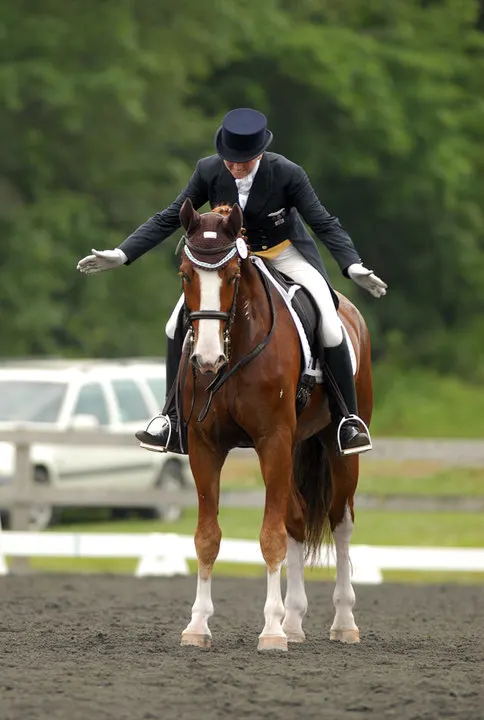I have been so lucky as to have some phenomenal horses in my life, including the three that I’ve trained up the levels from youngsters—Ella, Midgey and, on his way up, Fender. I often get asked what I’m looking for when I pick a young horse. How do I “know” what they’ll become?
I could give you the answer you’d expect—three good paces, uphill type, legs that all point the right direction, parents who did what I want them to do. But here’s the truth: at the end of the day, I really don’t, particularly not at 3 or 4 years old, and having tried them two or three times in a sales setting.
Which is not to say that I don’t hedge my bets by also getting horses that have three good paces, uphill type, etc. But what I’m hoping to find is a feeling I get when I work with them, that they’ll take an aid, that they won’t get totally irked when I push them out of their comfort zone, that they’re game for what I throw at them, and recover quickly, mentally and physically, from having the bar raised.
I want a horse who goes well when things are good, but I also want a horse who will stay with me when things are not. I don’t want one who dwells on mistakes, or who holds them against me. I want a horse who, when training or life get tough or scary, will dig in and fight for me, not with me.
I don’t expect that from nature. Certainly there are horses out there who are born wildly tolerant; these generally go on to be beginner-type horses, not the kinds of things I take to the CDI Grand Prix ring, which is totally a-OK. The world needs more beginner horses than international Grand Prix horses, for sure!
(But I’ve also met several horses over my career owned by real serious beginner riders who will cheerfully toddle around the ring with them, reins flopping, legs discombobulated; but when I get on and ask for a real connection over the back from hind legs to the bridle, the horse knocks on the door of dangerous. Those horses have an understanding with the universe—ask little of me and I will be your best friend; go out of my comfort zone and I will eat you for breakfast. Fine by me, buddy.)
For most horses, tolerance—rideability, pressureability, whatever you want to call The Ability To Suck It Up And Do As The Rider Says—is learned. By testing boundaries, young horses figure out where the boundaries are, and take comfort from that. By being nudged out of their comfort zones, young horses learn that their humans will never let them get in trouble, never let them get eaten by the lions, and learn that the rules are the same every day, and can be trusted. Putting pressure on young horses helps them make sense of the world. And the more reasonable pressure they can take as kids, the more trustworthy and confident they’ll be in themselves as adults.
ADVERTISEMENT
I don’t mean we should be roughing them up, or showing them Grand Prix at 7. But I want a horse that Lets Me Drive at 11 years old, which sometimes means they’re a pretty big dork at 5, at 7, at 9. We joke at my farm that we seal juvenile records for a reason. Some of the biggest pigs in the world as kids ended up being delightful, charming, amateur-safe grown ups.
Midge got us eliminated as late as his 9-year-old year for standing on his hind legs; at 10, he was the most broke, easy, confident thing you’ve ever met. I met Cleo for the first time, before I owned her, at 4 or 5, having broken loose from her stall at Sorensen Equestrian Center in Wisconsin, and tearing loose around the place, unwilling to be caught. By 8, she was Little (or, rather, Big) Miss Perfect, and at 12 she was a wonderful schoolmaster for my mother.
I think it’s the fact that these guys were a little tricky as kids that made them into such fabulous adults. The coping skills that teach them to stand in a stall, accept a leg aid, work when they’re tired, and on and on are the same things that let them tolerate a rider that doesn’t sit square in the saddle 100% of the time, or a 20-something kid trainer who sometimes gets greedy and stupid. It equips them to deal with life.
And the more teenage humans I teach, the more I think the same is true of them, too. Some kids are just cool, but even the coolest ones still run up against something hard and scary and emerge on the other side. And that teaches them that life will be ok, just like it teaches the horses. Leg yields, trailer rides and standing at the mounting block are the equine equivalent of second place ribbons, asking a girl to Homecoming and the SATs. They teach our young, two-legged and four-, that the world isn’t going to adjust to them, but that it is, in the end, all going to be ok.
Those coping skills I teach my young horses—and, I hope, my young students—may not be enough to make them Grand Prix Superstars. But it’ll make them a more marketable amateur’s schoolmaster. They may not win the NAJYRC—they may even stop riding as adults; many young talented equestrians do—but competing there will make job interviews and dinner with the Vice President of Sales for the Pacific Northwest much less of a Big Deal.
Sometimes getting kicked in the teeth by life at 5 or 6 or 7 horse years, or 13 or 16 or 22 human years old, is exactly what is needed to make the future brilliantly bright. Talent, gaits, pedigree—it isn’t enough.















